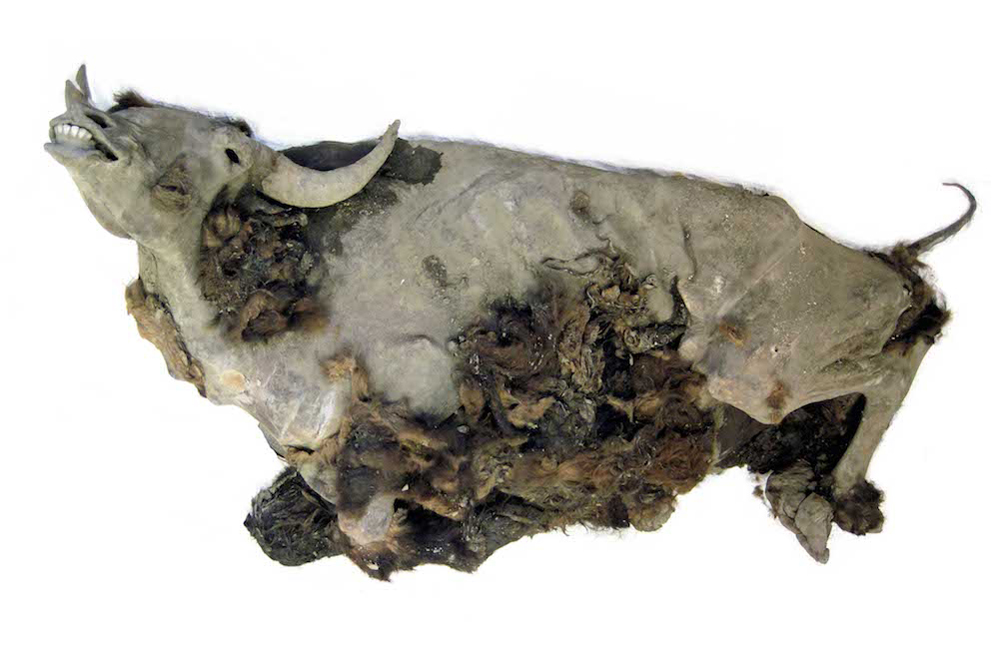9,000-Year-Old Bison Mummy Found Frozen in Time

This story was updated at 11 a.m. ET on Nov. 7.
Hidden away under frozen ground for nearly 10,000 years, an extremely well-preserved bison mummy is finally ready to give up its secrets.
In 2011, members of the Yukagir tribe in northern Siberia discovered the remains of a steppe bison (Bison priscus), an extinct ancestor of the modern bisonthat still roam the plains of North America and northern Europe. The almost perfectly preserved bison was transported to the Yakutian Academy of Sciences in Siberia, where researchers made plans to perform a necropsy, an autopsy performed on animals.
While other steppe bison mummies have been discovered over the years, none have been as well-preserved as the so-called Yukagir bison mummy, which was found with its internal organs almost completely intact, according to Olga Potapova, the collections curator and manager at the Mammoth Site of Hot Springs in South Dakota, who helped study the ancient mammal. [Photos: 9,000-Year-Old Bison Mummy Frozen in Time]
"Normally, what you find with the mummiesof megafauna in North America or Siberia is partial carcasses. They're partly eaten or destroyed because they're lying in the permafrost for tens of thousands of years," Potapova told Live Science. "But the mummy was preserved so well that it [earned] a record for the level of its preservation."
The researchers think the Yukagir bison died young, at about 4 years old, Potapova said. The lack of fat around the bison's abdomen suggests the animal died of starvation.
But other than that missing layer of fat, the bison was very well-preserved, with its heart, blood vessels and digestive systemfound relatively in tact, though some of the organs had shrunk significantly, the researchers said. The specimen was so well-preserved that researchers were able to obtain tissue samples from each organ, Potapova said.
Get the world’s most fascinating discoveries delivered straight to your inbox.
The bison mummy's brain was also very well-preserved, according to Albert Protopopov, chief of the mammoth fauna research department at the YakutianAcademy of Sciences. And this is the first time that a steppe bison's brain tissue has been found intact, Protopopov told Live Science via Potapova, who translated his statements.
The bison's brain was removed from the animal's skull for further study, and the preliminary histology — or study of the brain tissue— is still underway, Protopopov added.
In addition to removing the bison's brain, the researchers also took out the rest of its internal organs, to study the tissues. The goal of the research is to collect data about this ancient bison that can then be used to compare it to modern bison species, said Natalia Serduk, a senior researcher at the Russian Academy of Sciences in Moscow, who is also involved in the study.
To confirm that this frozen mammal really was a steppe bison, the researchers used mitochondrial DNA found within the animal's tissues to perform a species identification test. They used carbon dating to determine how long ago the animal lived, Serduk told Live Science via Potapova, who translated her statements.
"Anatomy, physiology, genetics — these give us very good information to construct the bison's habitat, behavior and style of life. If we get all this information, we'll be able to pin down the real reasons for the extinction of the species," Potapova said.
The findings were presented at the annual meeting of the Society of Vertebrate Paleontology in Berlin and will be published in the Journal of Vertebrate Paleontology.
Editor's Note: This story was updated to correct a statement on how mitochondrial DNA from the mummy was used by the researchers.
Follow Elizabeth Palermo @techEpalermo. Follow Live Science @livescience, Facebook & Google+. Original article on Live Science .


